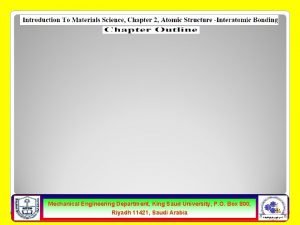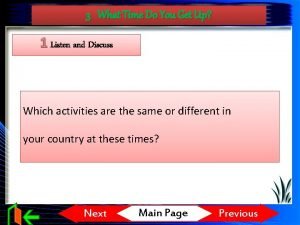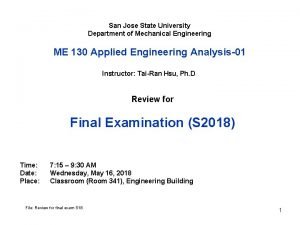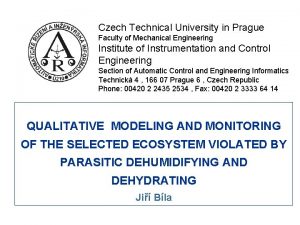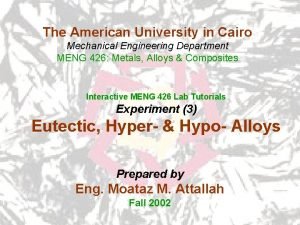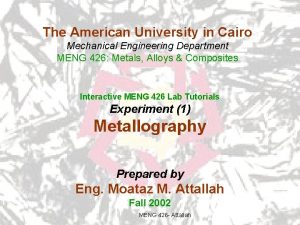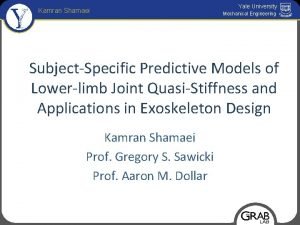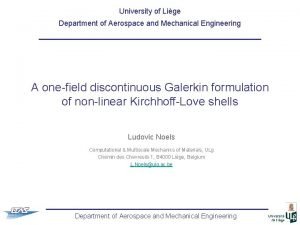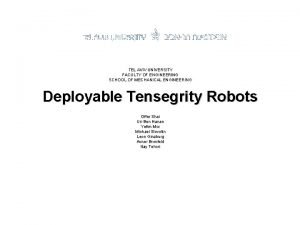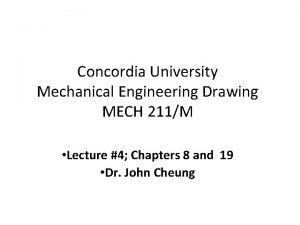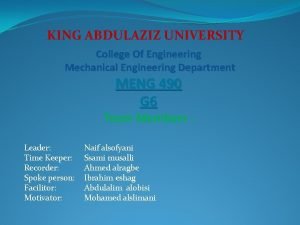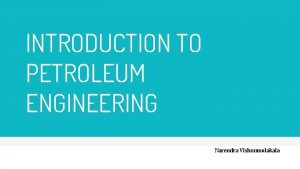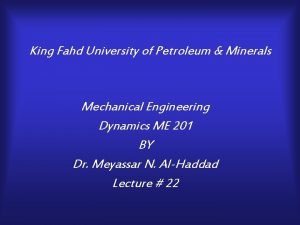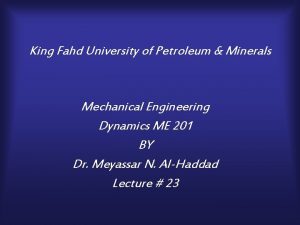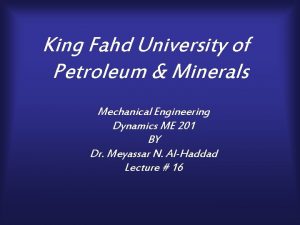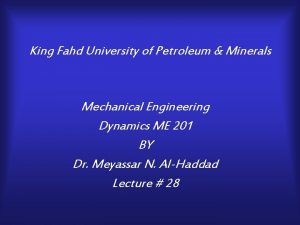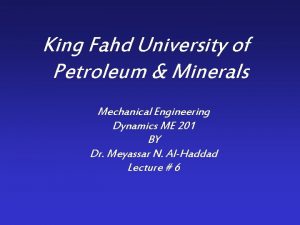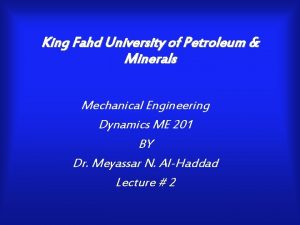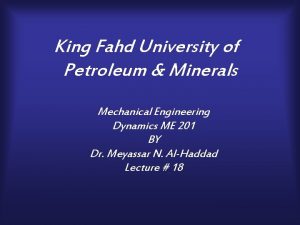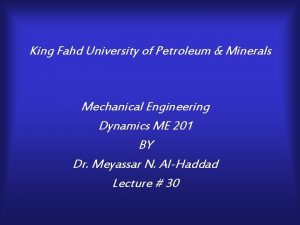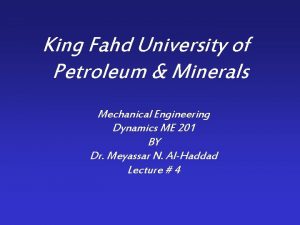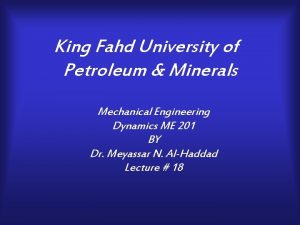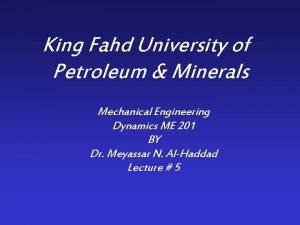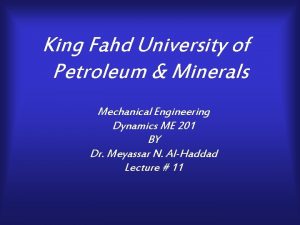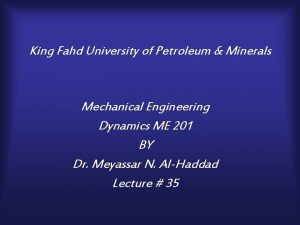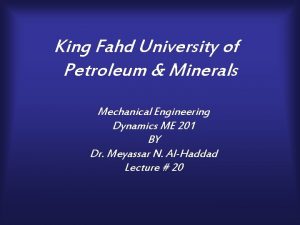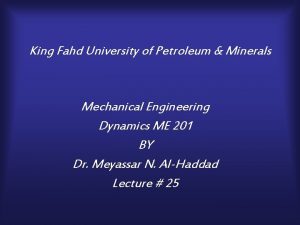King Fahd University of Petroleum Minerals Mechanical Engineering

















- Slides: 17

King Fahd University of Petroleum & Minerals Mechanical Engineering Dynamics ME 201 BY Dr. Meyassar N. Al-Haddad Lecture # 9

Review Chapter 12 • 12. 1 Introduction • 12. 2 Rectilinear Kinematics • 12. 4 General Curvilinear Motion – – 12. 5 Rectangular components 12. 6 Motion of a Projectile 12. 7 Normal and Tangential 12. 8 Polar and Cylindrical • 12. 9 Absolute Dependent Motion Analysis • 12. 10 Relative motion of two particles

12. 1 Introduction Mechanics Rigid-body Deformable-body Static Dynamics Equilibrium body Accelerated motion body Kinematics (Geometric aspect of motion) Kinetics (Analysis of force causing the motion) fluid

KINEMATICS OF PARTICLES Road Map Kinematics of particles Rectilinear motion x-y coord. Curvilinear motion Relative motion n-t coord. r- coord.

Areas of mechanics (section 12. 1) 1) Statics (CE-201) - Concerned with body at rest 2) Dynamics - Concerned with body in motion 1. Kinematics, is a study the geometry of the motion s, v, a 2. Kinetics, is a study of forces cause the motion F, m, motion

12. 2 Rectilinear Kinematics • Time dependent acceleration • Constant acceleration This applies to a freely falling object:

General Curvilinear Motion – Rectangular Components • Position vector r = x i + y j + z k • Velocity v = vx i + vy j + vz k • Acceleration a = ax i + ay j +az k (tangent to path) (tangent to hodograph) – Normal and Tangential Components • Radius of curvature (r) • Velocity • Acceleration – Polar & Cylindrical Components • Position • Velocity • Acceleration r = r ur

12. 6 Motion of a Projectile Horizontal Motion Vertical Motion ac= -g = 9. 81 m/s 2 = 32. 2 ft/s 2

• 12. 9 Absolute Dependent Motion of Two Particles – Position – Velocity – Acceleration • 12. 10 Relative-Motion Analysis of Two Particles Using Translating Axes – Position – Velocity – Acceleration

Review problems • • • 25 Examples 10 Homework Problems 10 Old Homework Problems 13 Problems in appendix D page 655&666 Problems included in the Lecture Notes

Continuous Motion • The position of a particle is s = (0. 5 t 3+4 t) ft, where t is in second. Determine the velocity and the acceleration of the particle when t = 3 s.

Projectile • Determine the speed at which the basketball at A must be thrown at the angle of 30 o so that it makes it to the basket at B. At what speed does it pass through the hoop? Horizontal Vertical

Normal and Tangential • At a given instant, the automobile has a speed of 25 m/s and an acceleration of 3 m/s 2 acting in the direction shown. Determine the radius of curvature of the path and the rate of increase of the automobile’s speed.

Polar and Cylindrical • The slotted fork is rotating about O at a constant rate of 3 rad/s. Determine the radial and transverse components of velocity and acceleration of the pin A at the instant = 360 o. The path is defined by the spiral groove r = (5+ /p) in. , where is in radians.

Dependent Motion • Determine the speed of point P on the cable in order to lift the platform at 2 m/s

Relative independent motion • At the instant shown, cars A and B are traveling at the speeds shown. If B is accelerating at 1200 km/h 2 while A maintains a constant speed, determine the velocity and acceleration of A with respect to B.

 King saud university mechanical engineering
King saud university mechanical engineering Milk alkali syndrome
Milk alkali syndrome Fahd: hi, ryan. where are you going?
Fahd: hi, ryan. where are you going? Fuente del rey fahd
Fuente del rey fahd Ytu erasmus ofisi
Ytu erasmus ofisi Sjsu mechanical engineering
Sjsu mechanical engineering Czech technical university mechanical engineering
Czech technical university mechanical engineering American university mechanical engineering
American university mechanical engineering American university mechanical engineering
American university mechanical engineering Yale university mechanical engineering
Yale university mechanical engineering University of florida mechanical engineering
University of florida mechanical engineering Tel aviv university mechanical engineering
Tel aviv university mechanical engineering Concordia university mechanical engineering
Concordia university mechanical engineering Faculty of mechanical engineering thammasat university
Faculty of mechanical engineering thammasat university College of engineering, king abdulaziz university
College of engineering, king abdulaziz university Petroleum engineering pros and cons
Petroleum engineering pros and cons Petroleum engineering and development company
Petroleum engineering and development company Ufa state petroleum technological university
Ufa state petroleum technological university
